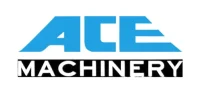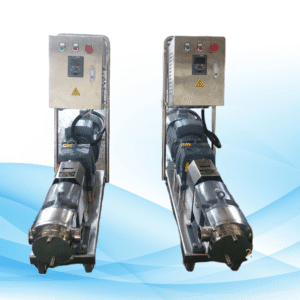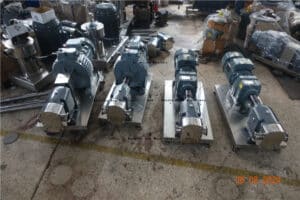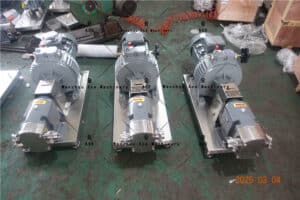A Quick Overview of Rotary Lobe Pumps
Positive Displacement Rotary Lobe Pumps
The Lobe pumps are quite appreciated in regard to their efficiency as well as reliability. These pumps use rotating lobes to induce motion in the fluid, and they are very important in such industries as food and beverage, pharmaceutical and wastewater treatment. The design of the lobe pump encourages a great amount of variations in terms of viscosity, making it a most sought after pump. The current blog is centered around explaining the working principles, including applications, benefits, and future developments connected with rotary lobe pumps in order to enhance the knowledge of those working and interested in the industry.

Operating Principles of Rotary Lobe Pumps
Basic Mechanics
Rotary lobe pumps operate on a simple yet effective mechanism. Within the pump housing, as the lobes rotate, along with the lobes, some fluid is trapped, thus alternating volumes of fluid are drawn in and then expelled. Usually, such rotation is caused by some drive mechanism in a system, which can be electrical or hydraulic.
Lobe Design and Function
The design of the lobes is very critical, in fact, relative to the pump’s performance. In normal circumstances due to manufacturing purposes, lobes are either rubber based or metallic and their configuration often differs considering their functions. This particular geometry facilitates a simple fluid movement with no shear effect, which is suitable for delicate fluids. During operation, when bean shape lobes rotate, a vacuum is created within the pump which draws fluid into the chamber. The fluid is quenched between the lobes and the closure and as the lobes both rotate, the fluid is forced out through the outlet. This procedure guarantees there is fluid in stream with very little pulse. The pump housing is constructed to absorb high pressure and have capacity for the rotary lobes. Seals are also a major component as they prevent leaking, thereby protecting the pump from damage due to operating under extreme pressure. Different types of sealing materials can be employed based on the type of fluid and the conditions which are utilized. The drive system is the one that supplies the rotary motion to the lobes. The most frequent instances are electric motors that are easy to operate and maintain, and hydraulic drives for heavy uses. All the variations in design single vs double lobe rotary lobe pumps may be single lobe and double lobe pumps. Single lobe pumps are usually less complex and therefore less expensive, while double lobe pumps enhance the efficiency and increase the flow rate making them too complex for simpler processes.
Material Considerations
Selection of materials is crucial since it affects the lifespan and performance of the pump. For example, food grade materials are required in the food and beverage industry, and materials that withstand corrosion are required in the chemical processing applications.
Applications of Rotary Lobe Pumps
Food and Beverage Industry
Handling Viscous Fluids
When we come to the food and beverage industries, rotary lobe pumps are very effective in handling viscous fluid products like sauces, purées, and creams. The pumping action is gentle and does not break the product, which makes it suitable for food applications that are critical in nature.
Sanitation and Cleanability
Another important benefit is the way they can be cleaned, including disassembly when needed. Many rotary lobe pumps can be cleaned in such a way that they meet the hygiene requirements necessary for food preservation.
Chemical and Pharmaceutical Industries
Precision and Accuracy
When it comes to the pharmaceutical industry, we must say that the accuracy is very important. Rotary lobe pumps are capable of administering adequate doses without over dispensing or under dispensing as well as maintaining a flow rate, which is very important in drug formulation as well as during drug processing.
Pump Resistance
Most of the work in the chemical industry deals with chemicals that are corrosive. Rotary lobe pumps made of specific materials are able to survive to extreme conditions, which leads to safe and efficient operation for long periods of time.
Water Treatment and Sludge Handling
Rotary lobe pumps are very important in wastewater treatment plants, more so in the handling of sludge and other thick materials. There are exceptional benefits associated with this application, such as being able to transport highly viscous liquids without clogging.
Energy Efficiency
It has been established that rotary lobe pumps are energy efficient thereby economizing the operating cost in the wastewater treatment plants which makes it an eco-friendly method of resource management.
Advantages of Rotary Lobe Pumps
Versatile and Fitting with a Wide Range of Fluids
Slurry rotary lobe pumps at times stand out because of how versatile they are. The variety of fluids and fluids of high viscosity slurries and shear sensitive liquids can be computed with great ease by them.
Custom Configurations
These pumps are available in multiple configurations to be used for specific applications, hence aiding in enhancing performance efficiency for various industries.
Maintenance and Strength
Durability maintenance aspects are made simple by coming up with components of the rotary lobe pumps which are structured in a manner that allows ease of service carrying out. Predictive maintenance helps to ensure that the pumps run at maximum utility, besides increasing their overall service life.
Long Service Life
With appropriate maintenance, rotary lobe pumps could have longevity, as they are dependable over a long period and are of great importance to the industries that depend on them.
Environmental and Economic Advantages
Energy Efficiency
Unlike standard pumps that require change of shutters, rotary lobe pumps are designed to save energy and costs in operation thus reducing the negative effect on the environment, hence are appropriate in a number of industries.
Cost-Effectiveness
Although the initial cost is higher compared to other pump types, rotary lobe pumps are favorable in the long run due to efficiency and less operating costs.
Case Studies and Examples
Successful Implementations
Example 1: Dairy Industry – Improved Efficiency
In the dairy industry, a dairy processing unit installed rotary lobe pumps for transferring cream and yogurt. There was great improvement into the operational effectiveness and quality of the product, as the pumps were able to move the thick fluids without damaging the product.
Example 2: Chemical Processing – Enhanced Safety
In a chemical processing site, rotary lobe pumps were used to move hazardous materials. Their rugged design and well-established operating principles not only enhanced security but also lowered the chance of leakage and spillage.
With regard to lessons learned, what key takeaways can be synthesized from the implementations
Industries that have successfully incorporated rotary lobe pumps report higher efficiency rates, shorter downtimes and better quality of products.
Unforeseen Hurdles Confronted in Diverse Sectors
Some of the common challenges are the varying viscosities of the fluids and achieving sealing in various apparatuses to prevent leakage. Technology and material science have started addressing these issues as well.
Addressing the Future Trends and Innovations
Technological Innovations
Smart Pump Solutions
Realizing the foresight for the rotary lobe pumps foresees technological advances into the monitoring and control of the operation of this pumping equipment. This innovation has the potential of enhancing performance and predicting failure in advance and therefore performing timely maintenance.
Integration of IoT
Further, there arises an opportunity to link IoT with rotary lobe pumps for data acquisition, which will enhance the operational system and assist in monitoring and taking corrective actions.
Lead Growth Markets
Emerging Market Opportunities
With continuous industrialization, this and other industries will grow and so the need for effective pumping systems. As competition looms in new markets, rotary lobe pumps are expected to become a viable product that offers growth potential for both manufacturers and suppliers in this category.
Trial And Error
New innovative fields, where the rotary lobe pump will be applicable, are emerging, especially in those fields needing high contamination control and accurate fluid positioning, including biotechnological and renewable energy sectors.
Summary
In closing, the advantages of rotary lobe pumps are especially evident in operation across various industries. Possessing such qualities as functionality, universality, and maintaining a healthy environment, they become desirable in a variety of applications. We can only hope for the uplifting future of rotary lobe pumps, along with the improving technology and new inventions waiting on the side. Do not hesitate, if you are planning to use rotary lobe pumps for your operations, or if you have any more questions. Discover the capabilities of rotary lobe pumps and discover how they can improve the performance of your business without delay today!


















